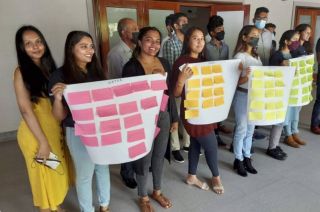
www.buildingsandcities.org/insights/commentaries/multi-level-climate-governance.html
Multi-level Climate Governance at COP27: Enable City Actions

By Liane Thuvander (Chalmers University) and Heba A.E.E. Khalil (Cairo University)
For COP27 to be a turning point in climate change action, it needs to pave the way for local projects and programs to proliferate. This may be most effectively achieved by establishing frameworks for context specific governance on multi-levels. How multi-level governance can support climate policy and what is needed to implement it effectively is shown. Two very different contexts demonstrate how climate governance acts at a city scale: Gothenburg, Sweden and Giza, Egypt.
Sweden: central government can enable cities
Sweden has a long tradition working with environmental and climate issues. By 1999 the Swedish Parliament had already adopted 15 environmental objectives. Two of them, "reduced climate impact" and "a good built environment", specifically address climate impact and cities. In 2017, a new climate policy framework was adopted providing a long-term signal to the market and other actors that Sweden is to achieve net zero GHG emissions by 2045 and to have negative net emissions after this.Despite these ambitious goals, the current monitoring indicates that Sweden is struggling to meet its target, illustrating the implementation gap.
Sweden also has national energy policy goals regarding renewables and energy efficiency, energy and carbon dioxide taxes, and promotes communication of policy instruments via national agencies. For instance, Boverket (Sweden's National Board of Housing, Building and Planning) supports the national goal of "a good built environment" by targeting efficient energy systems integrated with environmentally friendly and accessible public transport systems. A complementary policy adopted in 2018, "Designed Living Environments" identified architecture as one instrument (amongst others) to tackle climate change. Since January 2022, Boverket has required new buildings to provide declarations on their climate impacts. Additionally, regional and sector level strategies exist to create independence from fossil fuels and promote electrification. These strategies collectively target a broad range of stakeholders and include systems wider than city boundaries. Overall, the landscape of national, regional, and sectoral climate frameworks is comprehensive, but they give little guidance on how to translate commitments into action on the city level.
Local actions: the example of Gothenburg
Swedish cities are actively engaged and play a crucial role in the process of climate and energy transition, connecting local developments via urban planning to national frameworks and goals. In this perspective, the City of Gothenburg developed an Environmental and Climate Programme 2021-2030 based on goals for nature, climate, and people; to boost biodiversity, a near zero carbon footprint and a healthy living environment. The programme does not yet contain goals regarding climate change adaptation.
Gothenburg participates in theEU Mission for 100 climate-neutral cities by 2030, and has signed the Climate City Contract 2030, a contract between cities, government agencies and a strategic innovation programme. Beyond this, Gothenburg is also engaged in research projects with local universities and public organisations to co-produce knowledge, including the Centre for Sustainable Urban Futures. . The city has launched a research council to support and evaluate its climate policy. Finally, the city has designated responsible actors for implementation of their strategies. Thus, the city has frameworks for actions, lots of commitment and activities, and good knowledge of climate action implementation. But this does not necessarily lead to success, per se; additional efforts are needed.
A recent study of Gothenburg's Energy Plan (Maiullari et al. 2022) revealed that a high level of uncertainty and diversity among actors makes it difficult to identify common or shared pathways to follow. In the case of the energy plan, challenges regarding the coordination between different domains especially in energy and urban planning; the adaptation of systemic thinking to benefit the community rather than single stakes or stakeholders; and the lack of proper communication tools for the decision-makers to facilitate multi-domain processes.
In the Swedish case, comprehensive and mutually dependent frameworks and instruments for climate change action are in place, allowing multi-level action. Initial appraisals suggest that local implementation would benefit from exploratory instruments that consider a multiplicity of domains and actors' perspectives (public, private, non-state). This would help inform local decisions in the climate and energy transition context, as well as help prioritise strategies and assess the consequences of their implementation. Another aspect, not discussed here, is the question of by whom, and on what system level, the (financial) burdens should be placed?
Egypt: central government context
In the Global South, climate actions can come second to pressing development priorities. In a centralised, middle-income country as Egypt, climate action faces several structural challenges and barriers. One of the first barriers is to identify cities as a priority action area in climate action. Moreover, providing autonomy to cities in terms of actions and budgets is fundamental to realising actions and effective metropolitan governance. Doing so will facilitate coordinated actions between municipalities, as in the case of Greater Cairo Region (GCR).
The newly announced Nationally Determined Contributions (NDC) incorporated both mitigation and adaptation measures and encompass cities as a focal sector (Egypt 2022), which provides an overall political and institutional support for local level actions. The NDC document highlights current challenges and actions taken since the 2015 Intended Nationaly Determined Contributions (INDCs) which previously focussed only on national scale supply side interventions with limited local level actions. For instance, energy efficiency measures for low carbon transport, solid waste management and green finance were all implemented by the central government.
For buildings and urban cities, the new NDCs now identify mitigation targets for renewable energy and energy efficiency, green buildings, increasing green spaces, solar street lighting and even incorporate a National Active Mobility Strategy, to encourage citizens to walk and cycle. Regarding adaptation targets, in addition to the existing focus on water resources and irrigation; agriculture, and coastal zones that were previously part of the INDCs now a new sector for urban development and tourism to address climate resilience of touristic sites, road networks and endangered sites has been added. Thus, there is a shift towards local actions advocated by NDCs and which can be supported by a package of related laws, regulations and monitoring apparatus.
Giza's actions
Analysis of the Giza Climate Change Strategy Framework, suggested Giza's metropolitan governance faced challenges around knowledge, awareness, resources and capacity to advocate for and develop local climate change strategies and actions. These challenges limit the ability of Giza's metropolitan governance system to coordinate climate actions with other parts of GCR. Through the development of the Giza Climate Change Strategy Framework, five main strategic policies were identified: conserving resources; preserving the governorate's assets from climate change impacts; improving infrastructure and services to adapt to climate change; achieving low-emission development; and protecting citizens from the health impacts of climate change (Giza Governorate 2018).
Several prerequisites for effective climate action were identified that would fit similar cities within similar governance contexts. These consist of two groups: capacities and resources as prerequisites for governance framework, and inclusive cooperation. The capacities and resources requirements focus on raising climate change awareness, enabling local workable knowledge, providing technical and financial support from higher levels, implementing local climate impacts studies and raising capacities of local municipality employees. Inclusive cooperation focuses on increasing prioritisation of environmental welfare, creating co-benefits with development priorities, granting higher levels of autonomy, activating means of accountability and monitoring systems, creating long term climate change visions for all settlements, deploying effective and equitable public engagement mechanisms, coordination with other levels of the government (vertically and horizontally), and mainstreaming climate change into sensitive sectors like health and education(Eissa & Khalil 2022). Hence, it is vital to consider whether these prerequisites exist before deploying any climate strategies or plans to ensure applicability of actions.
Lessons for COP27
Overall, the Global North climate policies and strategies favour mitigation measures and focus on technical solutions or changes in habits. However, increasingly, the Global North is suffering from the impacts of climate change through heat waves and flooding for example. Thus, cities' climate strategies need to combine mitigation measures with adaptation measures and resilience actions.
Adaptation is already an important issue for the cities in the Global South as a result of increased vulnerabilities. Many climate actions by cities fall under mitigation rather than adaptation, often as a direct response to available international funds and initiatives. The latest IPCC report calls for integration of mitigation and adaptation agendas in all cities across the world. Climate action projects need to be mainstreamed and incorporated within current urban development policies not seen as separate activities.
All actions require relevant governance structures. As the examples from Sweden and Egypt show, there is no single solution. Multi-level governance offers an interlinked but open framework and enables action across different levels and organisations. It is crucial to pay attention to the context and how such a governance structure can perform effectively. Action at city level is central and many cities have capabilities to act. Resilient structures are needed in terms of capacity building and through broad stakeholder engagement and resources for implementation. Even within more centralised structures, a level of autonomy and partnership with other non-governmental stakeholders should be promoted and supported to ensure realisable actions at the local level. National leaders should consider this as they engage with the COP27 negotiations.
We want young people to perceive the future positively and not with anxiety. COP27 needs to become a game changer realising the vision to move from negotiations and planning to implementation. This means actions at-scale and on the ground, translating agreements and pledges to projects and programs on the city level that make a real difference.
References
City of Gothenburg, Environment and Climate Program.
Egypt. (2022). Egypt's First Updated Nationally Determined Contributions. UNFCCC. https://unfccc.int/documents/522817
Eissa, Y. & Khalil, H. A. E. E. (2022). Urban climate change governance within centralised governments: a case study of Giza, Egypt. Urban Forum, 33, 197-221. https://doi.org/10.1007/s12132-021-09441-9
Giza Governorate. (2018). Towards a Climate Change Strategy in Giza Governorate Framework Document. Giza Governorate.
Maiullari, D., Palm, A., Wallbaum, H., Thuvander, L. (2022). Pathways towards carbon neutrality: a participatory analysis of Gothenburg's energy plan. IOP Conference Series: Earth and Environmental Science, 1085, 012041.
Latest Peer-Reviewed Journal Content
Designing for pro-environmental behaviour change: the aspiration–reality gap
J Simpson & J Uttley
Lifetimes of demolished buildings in US and European cities
J Berglund-Brown, I Dobie, J Hewitt, C De Wolf & J Ochsendorf
Expanding the framework of urban living labs using grassroots methods
T Ahmed, I Delsante & L Migliavacca
Youth engagement in urban living labs: tools, methods and pedagogies
N Charalambous, C Panayi, C Mady, T Augustinčić & D Berc
Co-creating urban transformation: a stakeholder analysis for Germany’s heat transition
P Heger, C Bieber, M Hendawy & A Shooshtari
Placemaking living lab: creating resilient social and spatial infrastructures
M Dodd, N Madabhushi & R Lees
Church pipe organs: historical tuning records as indoor environmental evidence
B Bingley, A Knight & Y Xing
A framework for 1.5°C-aligned GHG budgets in architecture
G Betti, I Spaar, D Bachmann, A Jerosch-Herold, E Kühner, R Yang, K Avhad & S Sinning
Net zero retrofit of the building stock [editorial]
D Godoy-Shimizu & P Steadman
Co-learning in living labs: nurturing civic agency and resilience
A Belfield
The importance of multi-roles and code-switching in living labs
H Noller & A Tarik
Researchers’ shifting roles in living labs for knowledge co-production
C-C Dobre & G Faldi
Increasing civic resilience in urban living labs: city authorities’ roles
E Alatalo, M Laine & M Kyrönviita
Co-curation as civic practice in community engagement
Z Li, M Sunikka-Blank, R Purohit & F Samuel
Preserving buildings: emission reductions from circular economy strategies in Austria
N Alaux, V Kulmer, J Vogel & A Passer
Urban living labs: relationality between institutions and local circularity
P Palo, M Adelfio, J Lundin & E Brandão
Living labs: epistemic modelling, temporariness and land value
J Clossick, T Khonsari & U Steven
Co-creating interventions to prevent mosquito-borne disease transmission in hospitals
O Sloan Wood, E Lupenza, D M Agnello, J B Knudsen, M Msellem, K L Schiøler & F Saleh
Circularity at the neighbourhood scale: co-creative living lab lessons
J Honsa, A Versele, T Van de Kerckhove & C Piccardo
Positive energy districts and energy communities: how living labs create value
E Malakhatka, O Shafqat, A Sandoff & L Thuvander
Built environment governance and professionalism: the end of laissez-faire (again)
S Foxell
Co-creating justice in housing energy transitions through energy living labs
D Ricci, C Leiwakabessy, S van Wieringen, P de Koning & T Konstantinou
HVAC characterisation of existing Canadian buildings for decarbonisation retrofit identification
J Adebisi & J J McArthur
Simulation and the building performance gap [editorial]
M Donn
Developing criteria for effective building-sector commitments in nationally determined contributions
P Graham, K McFarlane & M Taheri
Join Our Community

The most important part of any journal is our people – readers, authors, reviewers, editorial board members and editors. You are cordially invited to join our community by joining our mailing list. We send out occasional emails about the journal – calls for papers, special issues, events and more.
We will not share your email with third parties. Read more



Latest Commentaries
COP30 Report
Matti Kuittinen (Aalto University) reflects on his experience of attending the 2025 UN Conference of the Parties in Belém, Brazil. The roadmaps and commitments failed to deliver the objectives of the 2025 Paris Agreement. However, 2 countries - Japan and Senegal - announced they are creating roadmaps to decarbonise their buildings. An international group of government ministers put housing on the agenda - specifying the need for reduced carbon and energy use along with affordability, quality and climate resilience.
Building-Related Research: New Context, New Challenges
Raymond J. Cole (University of British Columbia) reflects on the key challenges raised in the 34 commissioned essays for Buildings & Cities 5th anniversary. Not only are key research issues identified, but the consequences of changing contexts for conducting research and tailoring its influence on society are highlighted as key areas of action.